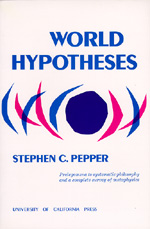When I was an undergrad at University of California, Berkeley, many students took a philosophy class with a professor named Stephen Pepper because it was supposed to be an easy A. It was held in a big lecture hall, and if people went, they often spent the class dozing. But I was intrigued.
 Professor Pepper was an expert in the tradition of pragmatism. In his most influential book, World Hypothesis: A Study in Evidence, published in 1942, Pepper argued that you need to apply both common sense and rigorous analysis when considering any problem because there is no such thing as pure, objective fact. Anytime you accept something as pure, objective fact, he believed, you inevitably open yourself up to false conclusions.
Professor Pepper was an expert in the tradition of pragmatism. In his most influential book, World Hypothesis: A Study in Evidence, published in 1942, Pepper argued that you need to apply both common sense and rigorous analysis when considering any problem because there is no such thing as pure, objective fact. Anytime you accept something as pure, objective fact, he believed, you inevitably open yourself up to false conclusions.
I wanted to understand Pepper’s lectures better, so I started dropping by to talk with him during office hours. I never had to wait; nobody ever went to see him. But to me it was a real privilege to spend half an hour with this man. He talked about how to frame your perspective about the world—basically, how to think. He wanted you to step outside the world you knew and question it from all angles, to dig into the details.
His ideas struck a chord. They certainly served me well when I was coming up in my early years as a securities analyst—and far beyond. I imagine this was at least partly because my faculty advisor at Berkeley, a truly brilliant man named Choh-Ming Li, had driven home a related idea in his lectures on international economics: “When you say something, understand the implicit assumptions of what you are saying.” I’ve quoted Professor Li on this point at one time or another to most every partner and colleague I’ve worked with.
If you want to be a problem solver and add real value, you always need to address and test your assumptions. The better you understand those assumptions, the better your decisions and solutions will be.

Leave a Reply